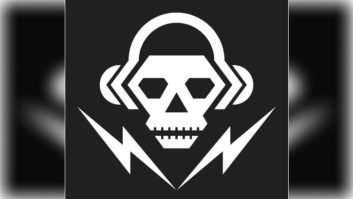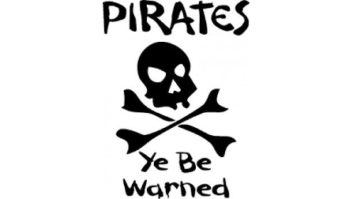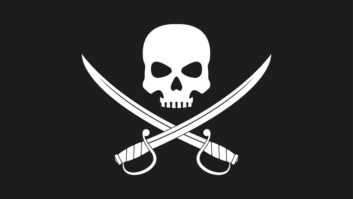Recently, our topic was “Stuff Pt. 1.” The links included William Hepburn’s Radio & TV DX info center, engineering radio and a cool look at how a future “radio house” was perceived with “radio in every room.” There were also a couple links to airchecks of KVIL in Dallas from ’67 and the first day of broadcasting from The Edge, KDGE, from ’89.
For this “Off the Beaten Path,” let’s take a look at something a little different, U.S. pirate radio stations. Now no “respectable broadcaster” would have anything to do with pirate stations. Besides the fact that they’re illegal in the U.S., we know how much interference they can cause and really how potentially threatening they can be for everyone to public services (fire and police) to aircraft communications.
I’m focusing on U.S. pirates — the U.K. and many other countries have their own well-known pirates (like ship-based “Radio Caroline” and others). In some countries, the broadcasting rules and regulations are so different that legit stations actually “float” their frequencies according to interference from the unlicensed broadcasters! In a future Off the Beaten Path, I’ll explore foreign pirate radio.
As I see it, there are two types of U.S. pirate stations. Those who know what they’re doing technically and just want their own “voice,” and the rest who have no regard or knowledge related to the technology. The latter are the mono broadcasters; the guys screaming at 150% modulation and splattering all over the dial; the boneheads who interfere with airline traffic and other forms of communication; the people screaming on a $10 microphones, cussing and trying to pick-up people of the opposite sex (“bootie callin’” as the pirates in Miami scream out). Both are illegal and subject to fines and prosecution.
It’s strange how you can travel from city to city and find no pirates to hearing pirates all over the dial. As a Miami area resident, at any given time I can find three or four pirates within range of my receiver (keeping in mind that there are dozens that may not be within range).
I can honestly say I have yet to find any that fall into the first category above (a “responsible pirate”). I hear songs that scream out about all sorts of “socially unacceptable behavior” and DJs screaming over the music “suggesting” to women that they can call them if they want to go “clubbin’” together, and on-air “personalities” which really make me cringe. All I could say about what I hear is that this is NOT broadcasting but truly “narrowcasting” and really makes me feel that the FCC should step up the fines and the government support stronger punishment. The problem with the fines is that I suspect this is like getting blood from a turnip. From what I’ve read through Radio World to the FCC’s sites, a large number of pirates seem to come out of this southern Florida area (including one pirate whose station interfered with commercial aircraft radio), Southern California and the New York area.
FCC & Pirates
This map is from the FCC. That’s a lot of pirates!

Here’s the FCC’s pirate home page.
And here’s the link to the information related to this map and the FCC.’s stance on pirates (including fines). Personally, I’d like to see all the fine money collected go back into the now defunct PTFP fund to help noncommercial broadcasters.
Frequently… maybe nearly always … you’ll find that the pirate stations feel they have the right to broadcast under the First Amendment’s freedom of speech rights. This is probably not the right venue to discuss this, though I think it’s safe to say that there isn’t enough spectrum for everyone to have their own piece of the spectrum. Also, there have been opportunities (through LPFM opportunities) for these groups to get licenses. If there is no unassigned spectrum under current technical rules, then there simply is no space. I would suggest that now, certainly more than any other time in the past, anyone who wants “their voice heard” has other opportunities (including the Web) to get their message out.
FCC Pirate Raid in Santa Cruz, Calif.
This pirate station even has the support of their local government and had been on the air for over eight years! This video (with a series of still images) shows the FCC raid on May 6, 2007.
Pirate Radio – KQLZ 100.3 LA
There are all sizes of pirate stations. KQLZ(FM) 100.3 MHz in Los Angeles is a large one. By their Web site, you can see they aren’t necessarily “hiding under a rock” but clearly visible and “out in the open” (as pirates often are). Note that the call letters actually belong to a legitimate broadcaster in North Dakota (New England/Beulah, N.D.). Radio-locator.com shows that there already is a strong signal (licensed station WSWD) 20 miles within L.A. Around that frequency is 99.5, 99.9, 100.1, (100.3), 100.7, 101.1, etc. As you’d expect, according to radio-locator.com, the market is heavily saturated with FM signals.
Though KQLZ indicates they’re online, they also describe how they’ve been on AM and FM in the past, they still indicate that they operate at 100.3 FM. Also of interest is to see that they take pride in using standard broadcast software (BSI’s Simian in this case) and paying streaming royalties (or saying they pay them — they are pirates, after all). They have an app too!
[Editor’s note: KQLZ was the call sign for Scott Shannon and Westwood One’s late 1980s/early 1990s Los Angeles-area “Pirate Radio” station on 100.3 MHz. The “Pirate” format was highly eclectic and the station considered a commercial failure though it did develop a cult following after shutting down.]
When a Pirate Goes Legit
In theory, I didn’t believe a station that was a pirate would ever be allowed a license. Even when filing for LPFM, you must state you have not been a pirate to get approval for you LPFM CP. I posted this link in the past, but it fits in very well in this Off the Beaten Path. I will say that this link is actually a series of links about this pirate and how it became a full-power licensed station, and it really plays out like a fascinating moving or TV series. I can’t say if it’s like “watching a train wreck” or a soap opera, but can say it’s interesting, fascinating, AND entertaining.
Start here with Part 1: (Note that this starts off like he’s tracking an “unknown pirate,” but in fact, he’s his own pirate!)
This link is to the entire series of videos.
Pirate “How-To”
There are plenty of opportunities to figure out how to start a pirate station. Besides the plethora of Chinese-made eBay FM transmitters, there are a lot of websites with info to help the pirate broadcaster. This certainly doesn’t make it right or legal, but it’s interesting to recognize what information the pirates are getting.
And finally …
Here’s a fun site to look at concerning licensed broadcasters and their history. This is the Museum of Broadcast Communications in Chicago. I see they their Web site is promoting upcoming awards ceremony and 2014 inductees (taking place in L.A. Nov. 9). Congratulations to a former employer who was a fascinating guy to speak with and pleasure to know… Mr. Stanley E. Hubbard (Hubbard Broadcasting), on his induction into the National Radio Hall of Fame!
If you stumble across a good or unusual web site that might be of interest, please don’t hesitate to send me the link and any info you might have about it. My email address is [email protected].









